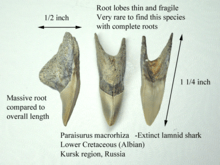Paraisurus
Paraisurus is an extremely rare extinct genus of mackerel sharks of uncertain affinities. It is sometimes placed in the family Cretoxyrhinidae. It lived in the Early Cretaceous, and is known in Europe, North America, and Asia.[1] It is mostly known from isolated teeth, which have a distinct shape. They are mesio-distally compressed, with a large labial protuberance. An associated dentition is known from the Weno Formation of Texas, USA.[2] Though originally presumed to go extinct towards the end of the Albian, an occurrence from the lower Atco formation implies survival into the early Coniacian.[3]
| Paraisurus | |
|---|---|
 | |
| Paraisurus macrorhiza tooth from the Albian of Russia | |
| Scientific classification | |
| Kingdom: | |
| Phylum: | |
| Class: | |
| Order: | |
| Family: | Incertae sedis |
| Genus: | Paraisurus Glückman 1957 |
Species
Species within this genus include:[1]
- Paraisurus macrorhiza
- Paraisurus compressus
- Paraisurus amudarjensis
gollark: This is not really, as far as I know, practical for machine-code-y systems, because they don't need to go through a function call or whatever to load new code for execution.
gollark: What I had to do one time to reverse some obfuscated code on potatOS was hook `load` to log newly loaded code to a file, it's called "Protocol Epsilon debug mode" and is still in there.
gollark: I'm assuming you don't mean "polymorphism" in the sense of "functions which can take/return multiple types"?
gollark: no.
gollark: Please note that you must execute JOIN or else.
References
- Gao, Keqin; Nessov, Lev A. (1998-06-03). "Early Cretaceous Squamates from the Kyzylkum Desert, Uzbekistan". Neues Jahrbuch für Geologie und Paläontologie - Abhandlungen. 207 (3): 289–309. doi:10.1127/njgpa/207/1998/289. ISSN 0077-7749.
- Welton, Bruce J.; Farish, Roger F. (1993). The Collector's Guide to Fossil Sharks and Rays from the Cretaceous of Texas. Before Time.
- Hamm, Shawn A.; Cucimurri, David J. (2011). "Early Coniacian (Late Cretaceous) selachian fauna from the basal Atco Formation, lower Austin Group, north central Texas". Paludicola. 8.3: 107–127.
This article is issued from Wikipedia. The text is licensed under Creative Commons - Attribution - Sharealike. Additional terms may apply for the media files.